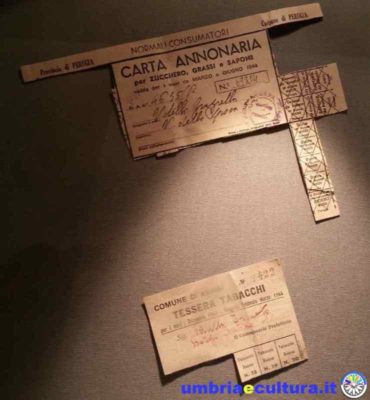In Palazzo Vallemani, the “Museum of Memory Assisi 1943-44” runs along 4 exhibition halls where, since 2011, thanks to the will of Marina Rosati and the courageous figure of Don Aldo Brunacci, the great little stories of ordinary heroism are shown to the public, to keep their memory alive, to pay them homage and to ensure that the lesson imparted by that unfortunate period will be always alive.
In Assisi, just over half a century ago, there were people who risked their lives to defend other human beings, without thinking about race or religion, without thinking about the risks, guided only by their sense of justice and piety.
Over 300 refugees were in Assisi during the Nazi-fascist ethnic cleansing and all were saved, none of them were deported or executed.
Assisi is a small city that can boast the honor of having as many as 7 “Righteous Among the Nations”, of which we will now, in summary, make the acquaintance, then leaving the reader the pleasure of deepening their stories and anecdotes by visiting the Museum.
“Righteous among the Nations” is the highest recognition of the Jewish state towards non-Jews who, at the cost of their lives, and non-profit, have worked to save people of Jewish religion.
The first is Don Aldo Brunacci, in fact, parish priest in Assisi, a city that welcomed many displaced people, attracted by the figure of St. Francis and the mystic aura of the city. Given the emergency, under the papal order, a welcoming committee was organized for these displaced persons, organized by Don Aldo. To direct the operations, Bishop Giuseppe Placido Nicolini, also recognized as Righteous among the Nations, an enlightened man thanks to whom, among other things, Saint Francis was named Patron of Italy.
The Jews were conveyed to the convent of San Francesco, and sorted from there to other convents or private homes.
In these stories, as some will know, there is also the figure of Gino Bartali, famous cycling champion, who shuttled between Assisi and Florence, carrying, inside the barrel of his bicycle, the false documents intended to donate to the Jews a new identity. Even Gino Bartali is recognized Righteous among the Nations.
In the next room we meet the figure of Father Rufino Niccacci, a figure of reference from the purely operational point of view, of this occult organization. Father Rufino was the Guardian Father of the convent of San Damiano and frequented the convent of San Quirico, one of the convents where the Jews were hidden. This convent also underwent an attempted raid by German troops; raid prevented by the Mother Superior of the convent, Mother Giuseppina Biviglia, also recognized, in December 2013, Righteous among the Nations.
Essential figures in this story are also those of the typographers, father and son, Luigi and Trento Brizi, who are also decorated with the recognition of Just among the Nations. In Assisi, clandestinely, they printed the documents destined to give a new identity to the fugitive Jews. The printing machine and the original equipment kit can be admired in the Museum. Following the example of other printers from northern Italy, they began clandestine activity, drawing inspiration, for the new surnames, from the telephone directories of southern Italy.
Also important was Dr. Muller, a German, a regime man, was the commander of the German troops in Assisi. Catholic, doctor, he went to pray to St. Francis every morning, although he was always aware of what was going on to save the Jews, and before leaving Assisi, during the retreat, he handed over to the Bishop and representatives of the Municipality , large quantities of drugs and medical material for the benefit of the population.
The city was decreed hospital city and therefore sheltered from bombing, thus allowing the salvation of human beings and historical and artistic testimonies unique in the world. This was also thanks to the intervention of the Podestà (the fascist mayor) of the time: Arnaldo Fortini, who worked hard to safeguard the city and even, despite being aware of the true identity of some Jews, never mentioned it.
The seventh recognition of Righteous Among the Nations was assigned to the order of the Stimmatine nuns, in memory of Sister Ermella Brandi.
A room of the Museum of Memory of Assisi host the collection of testimonies of daily life: the documents (with false names) for the distribution of food, to false identity cards, to the booklet that the children of the Jewish Viterbi family owned (later became Vanelli and finally Vitelli). To make the false identity more plausible, the girls studied by heart the booklet containing notes concerning, in their case, Puglia, the land of origin of their name, if they were subjected to interrogations by German soldiers.
There are a thousand stories and anecdotes kept in these rooms, the Museum of Memory in Asisi is a warning and a cry of hope, the human race is capable of so much malice but also, of enormous and superhuman goodness… this is what must make us hope for our future, in this era no less dark than the one narrated in these rooms. We all have to treasure past experiences, and our greatest treasure is Memory.
Benedetta Tintillini
Find the Museum of Memory on Google Maps:



